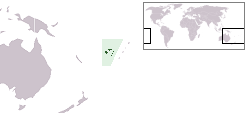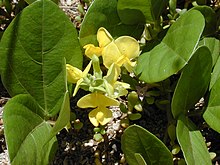Lakeba
 Map of Fiji | |
 | |
| Geography | |
|---|---|
| Location | Fiji |
| Coordinates | 18°13′S 178°47′W / 18.217°S 178.783°W |
| Archipelago | Lau Islands |
| Adjacent to | Koro Sea |
| Total islands | 1 |
| Major islands | 1 |
| Area | 59.5 km2 (23.0 sq mi)[1] |
| Length | 8.5 km (5.28 mi) |
| Administration | |
Fiji | |
| Division | Eastern |
| Province | Lau Province |
| Largest settlement | Tubou (pop. 500) |
| Demographics | |
| Population | 2100 (2014) |
| Pop. density | 35.3/km2 (91.4/sq mi) |
| Ethnic groups | Native Fijians, ) |
Lakeba (pronounced [laˈkemba]) is an island in Fiji’s Southern Lau Archipelago; the provincial capital of Lau is located here. The island is the tenth largest in Fiji, with a land area of nearly 60 square kilometers.[2] It is fertile and well watered, and encircled by a 29-kilometer road. Its closest neighbors are Aiwa and Nayau. Separated by deep sea from the latter but only by shallow waters from the former, when sea levels were lower during glacial episodes Lakeba and Aiwa formed one large island.[2]
It has a population of around 2,100 in eight villages, the most important of which is the capital Tubou which lies in the island's south. Near Tubou is the village of Levuka; not to be confused with its namesake – Fiji's old capital – Levuka on Lakeba is home to a fishing tribe whose ancestors came from Bau Island. Another significant village is Nasaqalau, located in the northern part of Lakeba.



Geography
Situated at 18.20° South and 178.80° East, Lakeba has an irregular oval shape. About 9 kilometers long and 8 kilometers wide, it is circumscribed by a total shoreline of 32 kilometers. The island, which has a maximum altitude of 219 meters, has a core of andesitic volcanic rock of Miocene age, with raised coral rock around it. The limestone lies bare in places, forming karst and – particularly on the north and north-west coasts – cliffs up to 76 meters high; the overall area taken up by bare limestone is about 4% of Lakeba's total land surface. A reforestation programme has seen the planting of Lakeba's hills (formerly partially denuded by deforestation) with Caribbean pine (Pinus caribea) trees.[3]
The
The village of Nasaqalau is noted for a number of caves, the most famous being Oso Nabukete, also known as the Pregnant Women's Cave. According to legend, a woman attempting to hide her pregnancy will not be able to escape through the mouth of the cave. It is adjoined by Qara Bulu, once used as a prison in times of tribal war. A third cave, Koro ni Vono, was once used as a place of banishment for tuberculosis patients, who were left there to die. Other notable caves include the Tubou Cave, of interest to geologists, and Qara ni Puka where many remains of extinct birds have been found.[2]

Climate
| Climate data for Lakeba (1991–2020 normals) | |||||||||||||
|---|---|---|---|---|---|---|---|---|---|---|---|---|---|
| Month | Jan | Feb | Mar | Apr | May | Jun | Jul | Aug | Sep | Oct | Nov | Dec | Year |
| Mean daily maximum °C (°F) | 30.5 (86.9) |
30.8 (87.4) |
30.7 (87.3) |
29.8 (85.6) |
28.5 (83.3) |
27.4 (81.3) |
26.7 (80.1) |
26.8 (80.2) |
27.4 (81.3) |
28.2 (82.8) |
29.3 (84.7) |
30.1 (86.2) |
28.9 (84.0) |
| Daily mean °C (°F) | 27.3 (81.1) |
27.6 (81.7) |
27.5 (81.5) |
26.9 (80.4) |
25.6 (78.1) |
24.9 (76.8) |
24.0 (75.2) |
24.1 (75.4) |
24.5 (76.1) |
25.2 (77.4) |
26.3 (79.3) |
27.0 (80.6) |
25.9 (78.6) |
| Mean daily minimum °C (°F) | 24.1 (75.4) |
24.4 (75.9) |
24.4 (75.9) |
24.1 (75.4) |
22.8 (73.0) |
22.3 (72.1) |
21.3 (70.3) |
21.3 (70.3) |
21.7 (71.1) |
22.3 (72.1) |
23.3 (73.9) |
23.9 (75.0) |
23 (73) |
| Average precipitation mm (inches) | 262.4 (10.33) |
224.8 (8.85) |
273.3 (10.76) |
230.8 (9.09) |
115.5 (4.55) |
120.5 (4.74) |
89.2 (3.51) |
94.8 (3.73) |
102.9 (4.05) |
112.8 (4.44) |
136.8 (5.39) |
229.8 (9.05) |
1,993.6 (78.49) |
| Average precipitation days (≥ 1.0 mm) | 14.4 | 14.2 | 15.7 | 13.9 | 10.7 | 8.0 | 8.3 | 8.3 | 7.9 | 8.1 | 9.3 | 13.5 | 132.3 |
| Source: World Meteorological Organization[5] | |||||||||||||
History and culture
Lakeba is known as a chiefly island, being the home island of the
Ratu Mara is buried in the village of Tubou, as are
Lakeba lies on a historical faultline between Fiji and Tonga, and Tongan influence is seen in many aspects of Lakeban culture. Lakeban architecture features rounded houses rather than the square-ended ones elsewhere in Fiji. The Lakeban dialect of Fijian also shows Tongan influence. Tongan hymns are popular in polotu (an evening church service), and Tongan clothing styles are reflected in the mats tied around the waist on formal occasions. Tongan traditional dances called lakalaka are also popular.
Archaeological excavations in the 1990s discovered a massive fortress, built around a thousand years ago. Large enough to house 2,500 people (more than the total population of the island), the fortress is believed to have been built as a bulwark against Tongan invaders.
The inhabitants of Nasaqalau are famous for the ability of one of their clans to call sharks from the sea. This clan originated in the village of Wainikeli on the island of Taveuni.
On Lakeba was born famous chief Delailoa, son of Kalouyalewa, who went on Lakeba.
Economy
Copra production is the most important economic activity on Lakeba. There is also a coconut mill four kilometers outside Tubou. Tourism is of lesser importance in Lakeba than in some other parts of Fiji.
Ecology
Due to the extensive and long-lasting settlement, the original ecosystem on Lakeba has been strongly altered. Terrestrial mammals, not originally native, have been introduces as livestock or stowaways, and today the island has horses, pigs, cattle, dogs, cats, and Polynesian (Rattus exulans) as well as black rats (R. rattus).[2]
Birds
Among land birds,
At least three species formerly found on Lakeba are now completely
However, on Aiwa a single bone was found, probably referrable either to the
Also found on Aiwa was a single bone of a
Plants


The former upland forest was largely cleared after the initial settlement to make room for agriculture; only about 5 km2 (1.9 sq mi) of it remain. A total 40% of Lakeba's surface is used for cultivation of Caribbean pine (Pinus caribaea), the rare cycad ("sago palm") Cycas seemannii, coconut palms (Cocos nucifera) and other crops. The remaining vegetation of Lakeba is dominated by dicots; it can be classified as follows, progressing from the peak to the shore:[4]
- Upland forest on volcanic soil. Little remains today, mostly in ravines and on ridges. Contains such species as Alyxia stellata, Alphitonia zizyphoides, Barringtonia edulis, Dysoxylum richii, Ficus scabra, Grewia crenata, Micromelum minutum, Pittosporum arborescens, Vavaea amicorum, and Geissois ternata which is only found on volcanic soils.
- talasiga Pennisetum polystachion and Themeda quadrivalvis. Regenerating forest is initially dominated by Cyclophyllum barbatum, Geissois ternata, Geniostoma rupestre, Leucosyke corymbulosa, Maesa tabacifolia and Myristica gillespieana.
- Upland forest on Maniltoa floribunda, Melicope cucullata and Planchonella tahitensis.
- Wetlands vegetation. Most freshwater wetland on Lakeba is used for taro cultivation. Otherwise, dominant plants include Ludwigia octovalvis and Mikania micrantha.
- Lowland swamp forest. Dominated by Inocarpus fagifer.
- Coastal forest. Characterized by Diospyros elliptica, D. samoensis, Planchonella tahitensis, Syzygium richii and Xylosma simulans.
- Mangrove forest. Mangroves are widespread on the eastern coast of Lakeba, comprising about 7% of the island's total area. Dominant plant species are black mangrove (Bruguiera gymnorhiza) landwards, and red mangrove (Rhizophora mangle), spotted mangrove (R. stylosa) and their sterile hybrid R. × selala seawards.
- Littoral forest. These trees are able to withstand seawater and most are even dispersed by the sea; they grow in a narrow strip along the beach. Dominant plants are sea poison tree (Barringtonia asiatica), ballnut (Calophyllum inophyllum), Hernandia nymphaeifolia, beach hibiscus (Hibiscus tiliaceus), Phaleria disperma and sea almond (Terminalia catappa).
- Littoral scrub. The low-lying and mainly herbaceous beach vegetation. Dominated by oceanblue morning glory (Ipomoea indica), white-flowered beach morning glory (I. littoralis), beach morning glory (I. pes-caprae), Pandanus tectorius, Paspalum vaginatum, Scaevola taccada and Vigna marina.
Plants found on Lakeba that are endemic to Fiji are
None of the described endemic species occurs exclusively on this island, but there is an unidentified Syzygium similar to Syzygium gracilipes and another member of this genus that almost certainly is a hitherto unknown species. These might indeed be found on Lakeba only.[4]
Interesting non-endemic plants found on Lakeba are the endangered Aglaia saltatorum and the rare (though not endangered) Burckella richii. In 1999-2001 the first Fijian record of Macropiper timothianum outside the large northwestern islands was made on Lakeba, as well as the first records for Fiji of Suicide Tree (Cerbera odollam) and Garuga floribunda. Whether Canarium vanikoroense, otherwise known in Fiji only from the large islands, occurs on Lakeba remains to be verified.[4]
Footnotes
References
- Franklin, Janet; Keppel, Gunnar & Whistler, W. Arthur (2008): The vegetation and flora of Lakeba, Nayau and Aiwa Islands, Central Lau Group, Fiji. Micronesica 40(1/2): 169–225. PDF fulltext
- ISBN 0-226-77142-3
